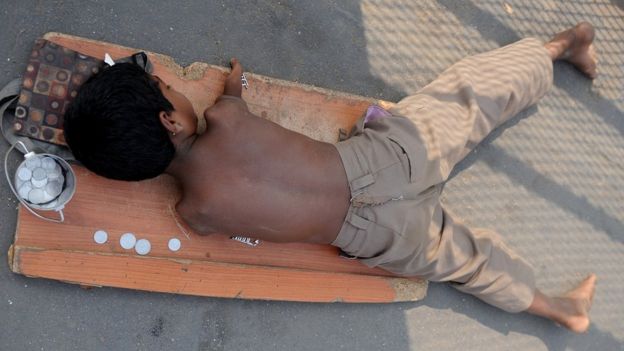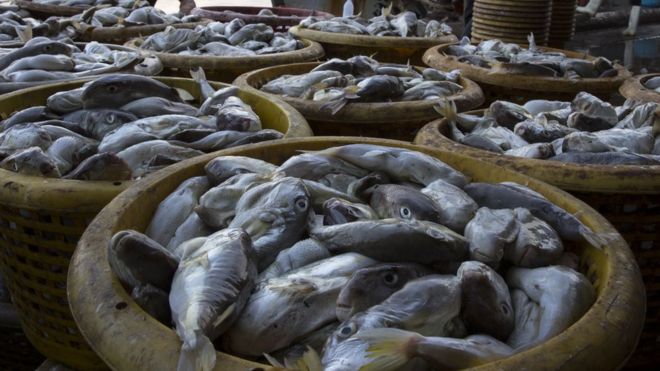The New (Hidden) Face of Slavery
"My family had to sell land, borrow money and even take out a bank loan to pay for it all. We were contracted to build a social housing development. For three months we got no salary at all. We thought our boss would pay us eventually, but then we discovered he'd fled to Singapore."
"We weren't able to make the monthly repayments [on the loan] so now we're in trouble. If we still can't pay back the bank, they're going to seize the deeds for my family's land. The bank's also lodged a police report against me, so when I do go back to Bangladesh, I might be detained."
24-year-old Bangladeshi construction worker
 |
| Children can be forced to beg on the streets (file photo) AFP |
So much for trust, for poverty persuading people to make risky efforts to retain employment and in the process laying themselves wide open not only for exploitation but to that added complications in their lives leading to penury and imprisonment through no fault of their own other than gullibility led on by desperation. It is what allows people from impoverished countries who cannot find work, hope for some dignity for their future when they agree to travel abroad -- and themselves pay for the privilege -- to work long hours for scant remuneration far from home, where there are no legal worker protections.
Going from the Philippines or Bangladesh to Saudi Arabia or Qatar to work on construction projects where they are housed in miserably squalid conditions, where there are no medical facilities available to them despite working in dangerous situations, and where the food allocated to them by their employers is of poor quality and quantity, failing to meet the daily energy requirements of construction workers. Often their passports are held for security purposes, and if workers are treated harshly and decide to leave for home, they are trapped without the documentation and the finances to allow them to.
 |
| Many trafficking victims are forced to work on fishing boats Getty images |
The long-gone era of slavery was a horrible time of people treated as possessions with no voice to protect them since slavery was accepted as normal; ownership of other human beings. It has been estimated that people sold into slavery represented 13 million souls at the height of the slave trade. At that time no government condemned the institution of slavery, it represented a valued commercial product in the age of emerging industrialization. For about 350 years people were forced into misery as slaves, automatons whose only purpose in life was to obey others
How fortunate we are, all of us, to live in an enlightened age when the institution of slavery is recognized for what it was; an unforgivable blight upon human history. There is now no such abomination assaulting and degrading humanity as trading in slaves, and people who took pride in their role of that trade as slave traders who would raid villages to gather people desperate to escape, many of whom died during their passage to the trading markets. Wars represented another generator of slaves.
Conflict persists. And so does slavery. The Yazidis of Iraq were murdered and the women and children enslaved by the Islamic State of Iraq and the Levant. But in Asia, there are poverty-stricken people who willingly allow themselves to be worked as slaves in the fishing industry, in mining. Above all, there are women who are forced into sex slavery, for there are huge profits to be made in forcing people to perform work that has financial value and that degrades the human spirit.
The United Nation's labour organization now calculates that there are at the present time, some 21 million people retained through some measure of modern slavery. If what happened in the past was reprehensible beyond shameful, what is now occurring is another age of slavery representing an atrocity of global proportions. It is a secret industry -- in reflection of its illegality.
 |
| Shandra and three other trafficking victims near a brothel in Connecticut. They were told to pose. Shandra Woworuntu |
It is estimated by those who follow this unsavoury and brutal subject of human trafficking that the most profitable of the slavery situations is women and girls who are trafficked in brothers. Generally, slaves forced to fish or mine minerals can generate roughly $4,000 each slave annually for those who exploit them. In contrast, the more lucrative trafficking is that of women where the profit represents an annual $36,000 income from each of the victims' activities.
Commonly, an innocent person eager for employment will be persuaded into 'debt bondage' whee employment agents promise them jobs in distant locales, have them sign for a loan to pay their passage the the fee the agent collects, and from them force repayment of the loan irrespective of the fact that the pay turns out to be less than promised and the work far more difficult, and in the process holding the passport as security.
Labels: Indentured Labour, Inhumanity, Sexual Bondage, Slavery

<< Home